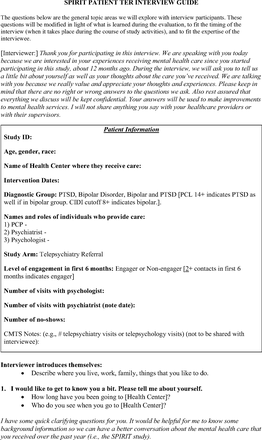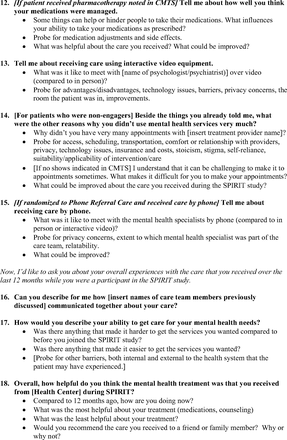Article Figures & Data
Figures
Tables
Total Arkansas Michigan Washington Patients 49 11 18 20 Telepsychiatry collaborative care 29 8 9 12 Telepsychiatry/Telepsychology enhanced referral 20 3 9 8 PTSD 28 6 11 11 Bipolar 21 5 7 9 Engagement status Engaged 36 11 12 13 Not engaged 13 0 6 7 Primary care clinicians 21 5 6 10 Degree: MD/DO 13 4 3 6 Degree: NP/PA 8 1 3 4 Champion status Champion 5 3 0 2 Nonchampion 16 2 6 8 Number of participating patients: 9 to 20 12 2 5 5 Number of participating patients: >20 9 3 1 5 PTSD, posttraumatic stress disorder.
Telepsychiatry Collaborative Care Telepsychiatry/Telepsychology Enhanced Referral Access to mental health care Provided access to specialty mental health care X X Facilitated patient comfort by providing care in familiar primary care setting X X Care quality and patient satisfaction Patients reported high-quality treatment X X Patients experienced overall satisfaction and improvements X X Alignment with patient readiness and suitability Better for patients with social anxiety, difficulty trusting and opening up to new people X – Better for patients that needed local support and/or help addressing social needs X – Better for patients ready for and in need of specific treatment modalities like CBT or CPT – X Better for the most complex patients, patients whose needs were not met in primary care – X Clinician involvement and responsibility Required greater clinician involvement in care X – Reduced clinician workload and responsibility – X Facilitated patient care continuity X – Easier for clinicians to maintain awareness about patient care and needs X – Clinician skill development Facilitated clinician skill development (eg, accurate mental health diagnoses and medication management) X – Abbreviations: CBT, cognitive behavioral therapy; CPT, cognitive processing therapy.

















